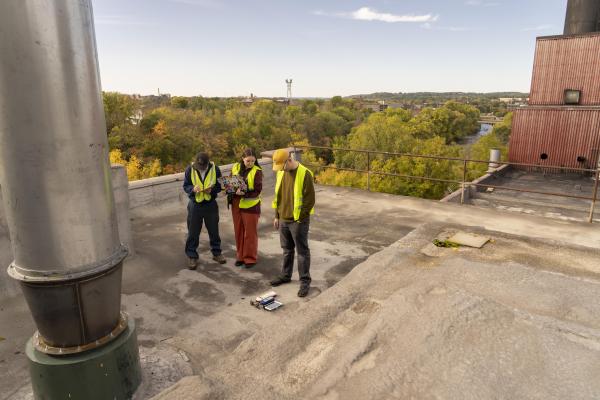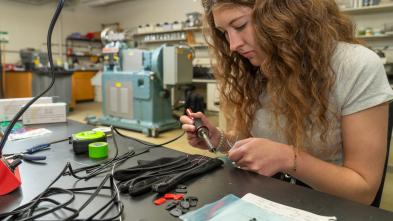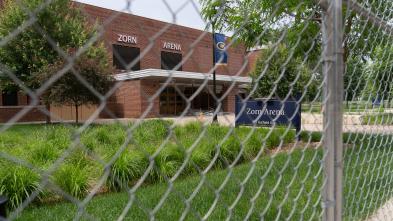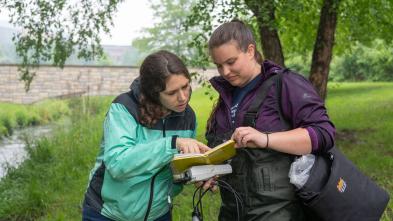
UW-Eau Claire partners with city to assess public health risk
A core value at the University of Wisconsin-Eau Claire is to serve as a community asset and resource, ready to partner with business and industry leaders to meet area needs. It seems that the community has heard this message, as area requests for campus assistance and expertise are increasingly common.
An exciting example of Blugold students taking part in this kind of exchange occurred in recent months when the Eau Claire City Council reached out to the university for help. Council member Andrew Werthmann had received complaints from East Hill residents related to a rubber manufacturer in Banbury Place, and he looked to the university to potentially examine the situation.
“There was a history of noise and odor coming from the rubber plant, and residents were concerned,” says Dr. Crispin Pierce, professor of environmental public health (ENPH). At the request of council members, he and student researchers devised a study to investigate the source of noise emissions at American Phoenix Inc. (API).

“When citizens are worried about the health of their families, there is a lot at stake,” Pierce says. “API was ready to find answers and potentially to make changes, so we agreed to take measurements alongside a representative of the Eau Claire City-County Health Department and help identify any needed course of action."
The best part about this type of project for the students, Pierce says, is that they see the true function of scientific research, to approach the work without bias and to let the findings speak for themselves.
“As scientists, we take the measurements assessing risk to human health and present them to the decision-makers. It’s then out of our hands, but our intent is that information leads to healthier communities,” Pierce says.

With careful adherence to safety protocols, Caleb Laufenberg (left), Dr. Crispin Pierce (center) and Courtney Roth made several visits to the rooftop of Banbury Place above American Pheonix Inc. to collect samples and measurements.
A team of student scientists
Pierce and a team of four environmental public health students got to work collecting data at six locations in the East Hill neighborhood and at five exhaust stacks on the roof of Banbury Place above the API facility. Multiple sets of measurements were taken in the various locations, before and after API implemented some changes to their operations.
Senior public health majors Sierra Roeske of Altoona and Emma Friesth of Fishers, Indiana, led the first set of noise sampling measurements in July 2023. Later phases of the study were led by fellow senior environmental public health majors Courtney Roth from Verndale, Minnesota, and Caleb Laufenberg of Hixton.
“After base measurements of the routine activity were taken, API did things like installing barrier walls and changing the rotations of the big fans, adjusting the revolutions per minute to make less noise when they slow down. We used a directional microphone to collect measurements in all directions at and near API, as well across the river in the residential neighborhood,” Roth says.

Gathered at one of the five API exhaust stacks monitored, Pierce and the student team await results as the decimeter measures the noise levels present in the second round of data collection.
For senior environmental public health major Caleb Laufenberg, this research project was his first opportunity to conduct on-site scientific data collection, a key skill set in the career paths that most interest him.
“My previous research experience in ENPH had been to analyze data that had already been collected,” Laufenberg says. “The noise study was a great research experience for me because it was more multifaceted, involving the in-person monitoring and data analysis, rather than just performing the analysis,” Laufenberg says. “Additionally, it felt great to be relied on in this study, knowing that our findings could potentially improve a neighborhood and the working conditions in API.”
Like Laufenberg, Roth felt both excited and a little nervous about playing a key role in research with “real-world” implications but felt confident in her classroom preparation to conduct the study.
“It is exciting to put our learning to use outside of the classroom, but there is added pressure because what we do affects real people,” Roth says.
What did the data show?
In late December, Pierce, Laufenberg and Roth presented the findings of data analysis to members of the Eau Claire City Council and representatives of API.
Pierce says the exact data summary is complicated, but concluded that API was not completely responsible for the levels of noise residents were reporting from their East Hill neighborhood.
“By comparing our baseline measurements with those collected after API’s engineering control measures had been put in place, we found a statistically significant drop in noise emissions at the API location," Pierce says. "However, the measurements did not show a statistically significant noise decrease in the surrounding neighborhood. This suggests that other sources of noise, vehicle traffic or other mechanical sources, contribute to neighborhood levels.”
API plant manager Mike Richards says it was gratifying to see that the data collected by Pierce and the student team confirmed the projected changes possible with their modification efforts.
"Using Air Movement and Control Association (AMCA) publications on vibration, sound pressure and directivity to identify near field improvements to reduce noise, we worked with industry leaders and Focus on Energy to develop and implement solutions to reduce noise and make the operation more energy efficient," Richards says.

“The difference in the noise levels Courtney and I measured between July and October showed nearly a 16-time decrease in decibels recorded. We also found that all the recorded levels were below the Occupational Safety and Health Administration's eight-hour permissible exposure limit for sound,” he says.
Grateful city officials
City Council members Joshua Miller and Werthmann helped coordinate the study from UW-Eau Claire, and Miller spoke to the value of UW-Eau Claire providing what he says was a careful and timely response to an urgent concern from city residents and API.
“In less than six months from our initial meetings, the UWEC team presented baseline findings and post-abatement final results with the stakeholders, which is a very fast turnaround for a project of this scale,” Miller says.
“The City of Eau Claire and its residents benefit greatly from having UWEC in our community,” Miller adds. “Dr. Pierce and the student team addressed a real concern affecting residents, an important project that also provided essential pre-professional experience for the team of researchers. Eau Claire would not be the city it is today without an expert community partner like UW-Eau Claire in our backyard.”
Other UWEC public health projects in the community

During a December Blugold basketball game, Pierce and ENPH students distributed earplugs for attendees to use during the sessions from the Varsity Band, especially useful for the youngest Blugold fans.
Additional community research projects in recent years by Blugold students in public health and environmental science include:
- A soil study at the public garden lot near Phoenix Park, testing for cadmium, chromium and lead.
- Installation of 14 air purifiers at the UW-Eau Claire Children’s Nature Academy, upcoming data collection of reported levels of influenza, COVID-19, RSV and strep throat to compare with past years.
- Surveys of band members and sound level study of performances by the Blugold Marching Band to determine if Environmental Protection Agency or Centers for Disease Control and Prevention guidelines would warrant the use of earplugs by band members and audiences.
If you are interested in taking part in ENPH community research or if you are a community member seeking information or testing/research concerning a matter of public health, please contact Dr. Crispin Pierce at 715-836-5589 or piercech@uwec.edu.
You may also like


